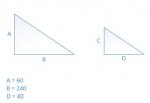It's been years since I've been in school and I've forgotten more than i care to admit. Howerver, I'm building a 200 ft guyed tower and wanted to know at what height above ground a guy wire would be at any given point. Consider a right triangle where A is the height to the first guy point and B is the distnace to my guy anchor. If i'm 200 ft away from the tower what would the height be at X? I'm not just looking for the answer but how to do the math.
A=60'
B=200'
See attachment.
A=60'
B=200'
See attachment.


